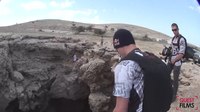
Photo from wikipedia
ABSTRACT Competitive skiers encounter a high risk of sustaining an ACL injury during jump-landing in downhill ski racing. Facing an injury-prone landing manoeuvre, there is a lack of knowledge regarding… Click to show full abstract
ABSTRACT Competitive skiers encounter a high risk of sustaining an ACL injury during jump-landing in downhill ski racing. Facing an injury-prone landing manoeuvre, there is a lack of knowledge regarding optimum control strategies. So, the purpose of the present study was to investigate possible neuromuscular control patterns to avoid injury during injury-prone jump-landing manoeuvres. A computational approach was used to generate a series of 190 injury-prone jump-landing manoeuvres based on a 25-degree-of-freedom sagittal plane musculoskeletal skier model. Using a dynamic optimization framework, each injury-prone landing manoeuvre was resolved to identify muscle activation patterns of the lower limbs and corresponding kinematic changes that reduce peak ACL force. In the 190 injury-prone jump-landing simulations, ACL forces peaked during the first 50 ms after ground contact. Optimized muscle activation patterns, that reduced peak ACL forces, showed increased activation of the monoarticular hip flexors, ankle dorsi- and plantar flexors as well as hamstrings prior to or during the early impact phase (<50 ms). The corresponding kinematic changes were characterized by increased hip and knee flexion and less backward lean of the skier at initial ground contact and the following impact phase. Injury prevention strategies should focus on increased activation of the monoarticular hip flexors, ankle plantar flexors and rapid and increased activation of the hamstrings in combination with a flexed landing position and decreased backward lean to reduce ACL injury risk during the early impact phase (<50 ms) of jump landing. Highlights First study investigating advantageous control strategies during injury-prone jump-landing manoeuvres in downhill skiing using a musculoskeletal simulation model and dynamic optimization framework. The simulation results predicted high injury risk during the first 50 ms after initial ground contact. Optimized neuromuscular control patterns showed adapted activation patterns (timing and amplitude) of muscles crossing the knee as well as the hip and ankle joints prior to and after initial ground contact, respectively. An optimized control strategy during an injury-prone landing manoeuvre was characterized kinematically by increasing hip and knee flexion and less backward lean of the skier at initial ground contact and the following impact phase.
Journal Title: European Journal of Sport Science
Year Published: 2022
Link to full text (if available)
Share on Social Media: Sign Up to like & get
recommendations!